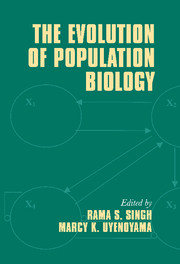Book contents
- Frontmatter
- Contents
- List of contributors
- Publications of R. C. Lewontin
- Preface
- Introduction
- Part I Historical foundations and perspectives
- Part II Genotypes to phenotypes: new genetic and bioinformatic advances
- Part III Phenotypes to fitness: genetics and ecology of populations
- Part IV Genes, organisms, and environment: evolutionary case studies
- Part V Applied population biology: biodiversity and food, disease, and health
- Index
Introduction
Published online by Cambridge University Press: 08 January 2010
- Frontmatter
- Contents
- List of contributors
- Publications of R. C. Lewontin
- Preface
- Introduction
- Part I Historical foundations and perspectives
- Part II Genotypes to phenotypes: new genetic and bioinformatic advances
- Part III Phenotypes to fitness: genetics and ecology of populations
- Part IV Genes, organisms, and environment: evolutionary case studies
- Part V Applied population biology: biodiversity and food, disease, and health
- Index
Summary
This series provides a forum for the review and discussion of some facets of the extraordinary intellectual contributions of Richard C. Lewontin. Previous volumes have addressed evolutionary genetics and the philosophy and politics of evolutionary biology. This volume invites consideration of the Lewontin/Levins vision of an integrated population biology.
R. C. Lewontin and Richard Levins outline the conceptual framework of population biology. They provide examples of the methodological developments the establishment of this field demands and of the kinds of insights it would inspire. Both, however, decry that this vision remains largely unfulfilled, nearly half a century after its explicit formulation as a scientific objective.
One advantage of starting with such a dyspeptic assessment is that each subsequent chapter can only contribute positive evidence that the precepts of population biology have become an inextricable part of modern evolutionary thought. In each of the several constituent fields of population biology, it has been the focused study of particular forces in isolation from the global network that has permitted major advances. This approach has entailed reduction of complex processes into more basic component mechanisms within a given level of biological organization and the substitution of simplified surrogates that represent lower levels in their entirety. The Lewontin/Levins vision of population biology challenges workers to transcend this very productive research strategy: to confront the considerable residual complexity that separates a biological system at a given level from its crude effigy assembled from independent building blocks and, even more difficult, to address interactions between levels.
- Type
- Chapter
- Information
- The Evolution of Population Biology , pp. 1 - 4Publisher: Cambridge University PressPrint publication year: 2004



